 Today’s Quick Question is a good one…
Today’s Quick Question is a good one…
When a specific requirement stated in a referenced standard is in conflict with what is allowed by the code that is referencing the standard, which requirement applies?
It’s not uncommon for more than one code to apply to a particular project – for example, some states adopt the International Building Code (IBC) during design and construction, and enforce NFPA 1 – Fire Code throughout the life of the building. To avoid problems, I normally recommend complying with the most stringent requirements of the adopted codes.
The quick question came to me with regard to conflicting requirements in NFPA 101-2018 and NFPA 80-2016. NFPA 101 allows entrance doors to individual dwelling units to have a separate deadbolt, but NFPA 80-2016 states: Doors other than those used in means of egress shall be permitted to be provided with dead bolts in addition to the active latch bolts or as otherwise permitted by the AHJ.
The fire-rated apartment entrance door serves as a means of egress for the apartment. NFPA 101 would allow the deadbolt, but NFPA 80 would only allow deadbolts on doors that are not in a means of egress (or as otherwise permitted by the AHJ). If we applied the most stringent requirement, the deadbolt would not be permitted (by NFPA 80), but the intent of NFPA 101 is to allow the separate deadbolt in this application.
The answer to this question is found in NFPA 101:
2.1(2) – Where the requirements of a referenced code or standard differ from the requirements of this Code, the requirements of this Code shall govern.
So if there is a conflict between NFPA 80 and NFPA 101, the requirements of NFPA 101 would govern. With that said, it’s best to address conflicts in the codes and standards with code changes whenever possible. The conflict related to deadbolts was removed in the 2019 edition of NFPA 80, when the deadbolt language was changed slightly:
6.4.4.3.1 Unless otherwise prohibited by applicable codes, doors shall be permitted to be provided with dead bolts in addition to the active latch bolts.
Any questions?
You need to login or register to bookmark/favorite this content.









Leave A Comment